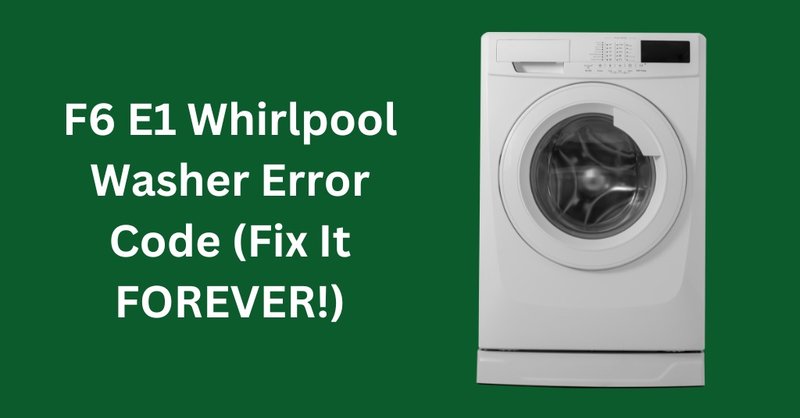
Dishwashers are a marvel of modern convenience, making our daily lives a little bit easier by taking on the laborious task of washing dishes. Yet, when they throw error codes like E1, it can be quite frustrating, especially if you’re just trying to get through your day. The good news is that understanding these codes is not as complicated as it might seem. In this article, we’ll dive into the mystery of the E1 code, break it down to its simplest form, and walk you through what you can do about it. Let’s unravel this together!
Understanding the E1 Error Code
The E1 error code is like a little message from your dishwasher saying, “Hey, something’s not quite right here!” Specifically, for Whirlpool dishwashers, the E1 error typically refers to a water temperature issue. It means that the water entering the machine or the water inside isn’t reaching the necessary temperature to effectively clean your dishes. Imagine trying to wash greasy dishes in cold water—it’s not very effective, right? The E1 code alerts you to a similar problem.
Why does this temperature issue happen? Well, your dishwasher relies on the house’s hot water supply to start with a high temperature. If the water heater is set too low, or if there’s a long pipe run that cools the water before it reaches the dishwasher, the machine might detect that the water isn’t hot enough. Another cause could be a malfunction within the dishwasher itself, such as a failing heating element that doesn’t heat the water to the desired temperature during the wash cycle.
Don’t worry, you’re not powerless against this error code! Identifying the underlying cause is the first step. Once you know that E1 is linked to water temperature, you can start investigating whether it’s an issue with your home’s water supply, the heater setting, or something inside the dishwasher. Now, let’s explore these potential problem areas and offer solutions.
Checking Your Hot Water Supply
The first thing to consider when you encounter an E1 error is your home’s hot water supply. Your dishwasher needs a minimum water temperature to effectively perform its cleaning duties. A good rule of thumb is that the water temperature should be at least 120 degrees Fahrenheit. If your water heater is set below this, your dishwasher might not get hot enough water to clean efficiently, triggering the E1 code.
To check this, simply run hot water at your kitchen sink for a minute or two and use a cooking thermometer to measure the temperature. If it’s too low, adjusting your water heater to a slightly higher temperature setting might solve the problem. It’s like giving your dishwasher the hot shower it needs to handle those tough dinner stains.
Another tip is to consider the distance between your dishwasher and the water heater. If they’re far apart, the water might cool as it travels through the pipes. In such cases, allowing the sink tap to run hot water briefly before starting the dishwasher can help ensure the machine starts with hotter water.
If you’ve checked these aspects and the error persists, there might be a more specific issue within the dishwasher itself. But no worries, we’re here to walk you through those too!
Exploring Internal Dishwasher Issues
Sometimes, the E1 error isn’t about your home’s water supply but rather about the dishwasher’s internal mechanisms. The heating element inside the dishwasher is crucial as it helps maintain and raise the water temperature during a cycle. Think of it like the heating coil in your electric kettle—if it breaks, the water never boils.
To check if the heating element is working, you’d typically listen for a subtle hum or look for any visible signs of damage if you’re comfortable doing so. For those who prefer not to tinker with the appliance, it might be time to consider calling a professional. They can easily test and replace the element if needed, getting your dishwasher back to its sparkling best.
Additionally, a faulty thermostat might misread water temperature, causing the error. The thermostat works like a sensor, reading the water temperature and instructing the heating element accordingly. If it’s malfunctioning, your dishwasher won’t know how hot the water is, leading to an E1 error.
Err on the side of caution here; if you’re not familiar with these components, consulting a repair technician might be the wisest approach. They can diagnose and fix the problem swiftly, so you can get back to effortlessly clean dishes.
Next Steps and Prevention Tips
So, what should you do once you’ve encountered and hopefully resolved the E1 error? Prevention is always better than cure. Regular maintenance can keep your dishwasher in tip-top shape. Consider running the dishwasher on its hottest setting regularly to keep the heating element and thermostat functioning well. Also, ensure that your home’s water heater is consistently set to a temperature that supports dishwasher efficiency.
If the E1 error seems to be a frequent visitor, it might be worth investing in a reliable professional service check. Maintenance checks can catch small problems before they become bigger issues, saving you time and hassle in the long run.
Lastly, always consult your dishwasher’s manual for tips specific to your model. Each dishwasher might have unique quirks or recommended settings, and knowing these can help you prevent future issues. With a bit of care and attention, your Whirlpool dishwasher can continue to be your trusty kitchen companion, free from the hassles of error codes!
By understanding and addressing the E1 error head-on, you’re well-equipped to handle it efficiently and keep your dishwasher running smoothly. And remember, when in doubt, seeking professional advice is always a smart move to ensure long-term peace of mind.